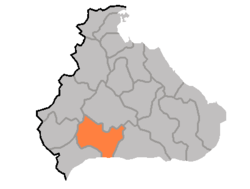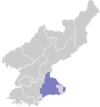Pyonggang County
P'yŏnggang County
평강군 | |
|---|---|
| Korean transcription(s) | |
| • Chosŏn'gŭl | 평강군 |
| • Hancha | 平康郡 |
| • McCune-Reischauer | P'yŏnggang-gun |
| • Revised Romanization | Pyeonggang-gun |
 Map of Kangwon showing the location of Pyonggang | |
| Country | North Korea |
| Province | Kangwŏn |
| Administrative divisions | 1 ŭp, 30 ri |
| Area | |
• Total | 708 km2 (273 sq mi) |
| Population (2008 census) | |
• Total | 90,425 |
| • Density | 130/km2 (330/sq mi) |
P'yŏnggang County is a kun, or county, in Kangwŏn province, North Korea. It borders Sep'o to the north, Ch'ŏrwŏn to the south, Ich'ŏn to the west, and Kimhwa to the east.
Physical features
[edit]A portion of the county is occupied by the Ryongam wetlands, which also cross into Ch'ŏrwŏn. Most of the county's terrain is mountainous, although there a few small expanses of level ground. The Kwangju and Majŏllyŏng mountains pass through P'yŏnggang. The region is prone to heavy rains.[citation needed]
History
[edit]The P'yŏnggang area was known as Puyang hyŏn during the Koguryŏ period, and as Kangp'yŏng (강평) under Silla. In the Koryŏ Dynasty, it was included in Tongju (동주); in the Chosŏn dynasty, it took its modern name.
Climate
[edit]| Climate data for Pyonggang (1991–2020) | |||||||||||||
|---|---|---|---|---|---|---|---|---|---|---|---|---|---|
| Month | Jan | Feb | Mar | Apr | May | Jun | Jul | Aug | Sep | Oct | Nov | Dec | Year |
| Mean daily maximum °C (°F) | −1.2 (29.8) |
2.0 (35.6) |
8.1 (46.6) |
15.8 (60.4) |
21.7 (71.1) |
25.3 (77.5) |
26.4 (79.5) |
27.5 (81.5) |
23.8 (74.8) |
17.9 (64.2) |
9.0 (48.2) |
0.8 (33.4) |
14.8 (58.6) |
| Daily mean °C (°F) | −7.0 (19.4) |
−3.6 (25.5) |
2.4 (36.3) |
9.2 (48.6) |
15.3 (59.5) |
19.9 (67.8) |
22.5 (72.5) |
22.9 (73.2) |
17.9 (64.2) |
11.1 (52.0) |
3.4 (38.1) |
−4.4 (24.1) |
9.1 (48.4) |
| Mean daily minimum °C (°F) | −13.3 (8.1) |
−9.4 (15.1) |
−3.1 (26.4) |
2.5 (36.5) |
9.2 (48.6) |
14.8 (58.6) |
19.1 (66.4) |
19.0 (66.2) |
12.6 (54.7) |
4.8 (40.6) |
−1.9 (28.6) |
−9.4 (15.1) |
3.7 (38.7) |
| Average precipitation mm (inches) | 11.5 (0.45) |
24.0 (0.94) |
25.4 (1.00) |
65.6 (2.58) |
92.5 (3.64) |
114.6 (4.51) |
369.9 (14.56) |
286.6 (11.28) |
108.4 (4.27) |
51.4 (2.02) |
40.4 (1.59) |
21.6 (0.85) |
1,211.9 (47.71) |
| Average precipitation days (≥ 0.1 mm) | 5.0 | 5.0 | 5.8 | 6.9 | 7.7 | 8.8 | 14.4 | 12.4 | 6.9 | 5.0 | 6.5 | 6.5 | 90.9 |
| Average snowy days | 5.2 | 3.9 | 3.5 | 0.5 | 0.0 | 0.0 | 0.0 | 0.0 | 0.0 | 0.0 | 2.0 | 5.5 | 20.6 |
| Average relative humidity (%) | 73.3 | 70.3 | 68.9 | 64.7 | 69.4 | 76.7 | 86.1 | 84.9 | 79.8 | 74.4 | 74.6 | 74.4 | 74.8 |
| Source: Korea Meteorological Administration[1] | |||||||||||||
Administrative divisions
[edit]On August 15, 1945, P'yŏnggang county included 1 ŭp (P'yŏnggang), 6 myŏn (Sŏ, Nam, Hyŏnnae, Mokchŏn, Sep'o, Yujin). Presently, it is divided into 1 ŭp and 30 ri (villages):
|
|
In addition, Jeongyeon-ri (정연리) in Galmal-Eup of Cheorwon County was traditionally part of Pyonggang County, and was the only part of the county that was ceded south after the Korean War.[2]
Economy
[edit]The county is well-suited to agriculture, and rice farming is especially developed. In addition, the mines of P'yŏnggang extract gold, tungsten, nepheline, zircon, alunite, and diatomaceous earth.[citation needed]
See also
[edit]References
[edit]- ^ "30 years report of Meteorological Observations in North Korea (1991 ~ 2020)" (PDF) (in Korean). Korea Meteorological Administration. pp. 225, 339, and 345. Archived (PDF) from the original on 29 January 2022. Retrieved 24 March 2022.
- ^ Encyclopedia of Korean Culture, 1996
External links
[edit]- In Korean language online encyclopedias:

